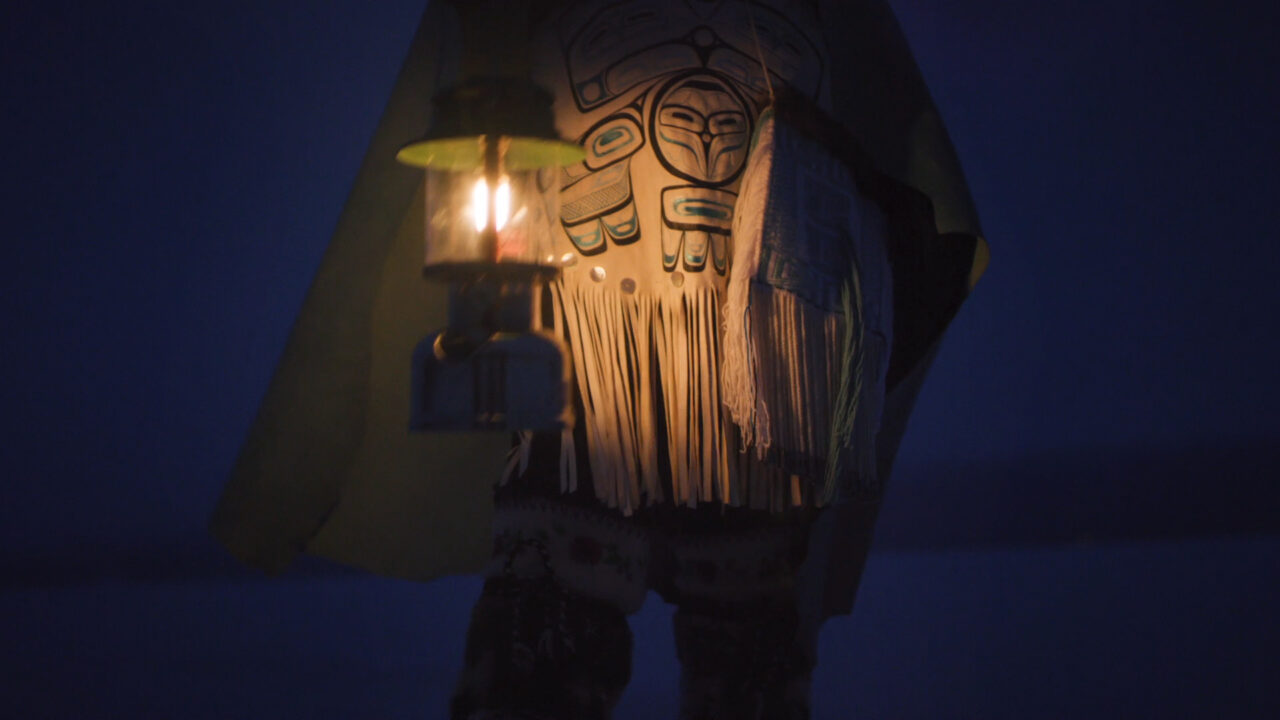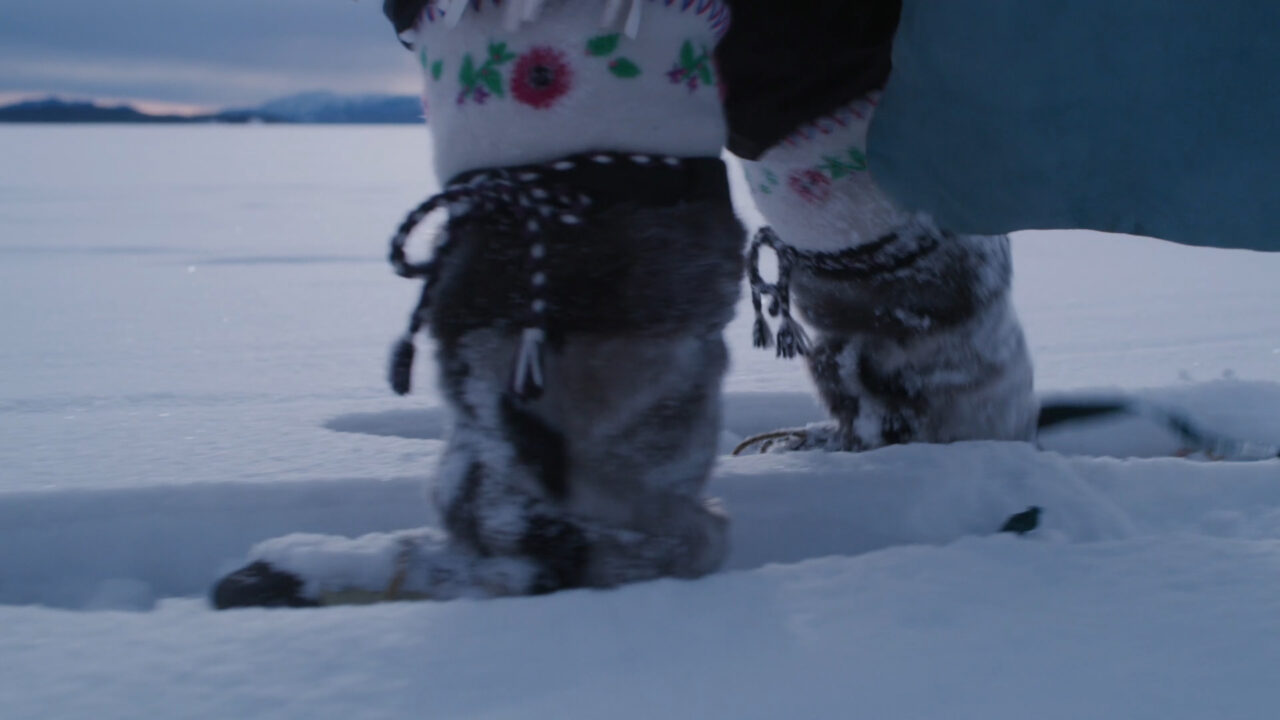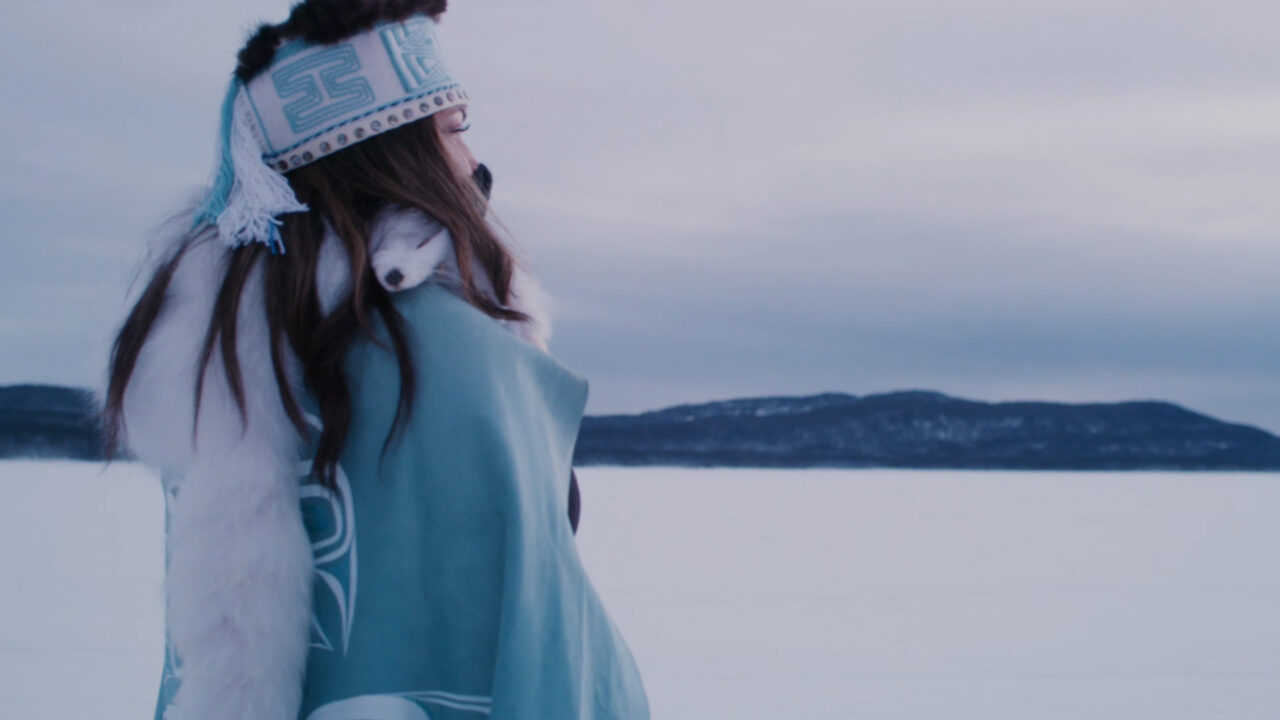Film Documenting Megan Jensen's Monumental Snow Artwork Weaves Together Myriad Influences

Posted on
The film, titled How Raven brought light to the world, touches on themes both intimate and omnipresent, says the artist and recent ECU grad.
A spectacular film featuring multidisciplinary Tlingit artist, cultural lead, community engagement specialist, language speaker and regalia creator Megan Jensen (BFA 2020) creating a monumental artwork in the snow is all the more spectacular for the many threads it draws together off-screen, Megan says.
Produced along with a team of artists for Travel Yukon, Megan says she was still feeling awed by the experience more than two months after filming had wrapped.
“Starting out, I had no idea it was going to turn into something so beautiful and meaningful, with so many different layers,” she tells me from her home Whitehorse, where she moved after graduation and now works as an art media specialist with the Yukon First Nation Education Directorate. “This video made me really believe in how things happen for a reason.”
The film, titled How Raven brought light to the world, features Megan telling a creation story about Raven. By transforming himself, the Raven tricks a great Chief into giving him three coveted boxes, containing the sun, moon and stars. Once opened, the celestial bodies are released spinning into the sky, bringing light to a dark world.

Still-frame from 'How Raven brought the light to the world.'
Megan’s telling of the story is spoken in Lingít (Tlingit). Megan is of Dakhká Tlingit and Tagish Khwáan Ancestry from the Dahk’laweidi Clan (killer whale) which falls under the wolf/eagle moiety. And while Megan is the focus of the film, she stresses the project was a team effort, with each member’s contribution a vital part of the epic work.
As Megan narrates the story, the video shows her dressed in regalia and wearing snowshoes. She walks across a darkened snowscape, lantern and book in hand. As the day grows brighter, the camera eventually pans up to reveal an immense Formline raven, drawn into the snow by Megan’s many thousands of footprints.
The effect is nothing short of stunning. As are the numbers: the final version took 15,400 snowshoe steps over 11 hours to complete; it measures 4 kilometres around, 300 feet across and covers an area of 1.62 acres; and more than 60 drone flights were needed to capture it all on video. To top it off, four trial runs were required to get it just right before the team was ready for the final installation. But as Megan points out, the most subtle aspects of the work are perhaps its most profound.

Still-frame from 'How Raven brought the light to the world.'
Megan was first asked to appear in the film by Shaunoh, a Haudenosaunee artist and filmmaker from Six Nations, and a director with Indigenous owned-and-operated film production company TSU North. An acquaintance for some time, Shaunoh approached Megan after speaking with her mother, who had given him the idea to make the film about the story of Raven bringing light to the world.
Inspired by land artists he had been researching, Shaunoh suggested drawing an image of Raven in the snow. Coincidentally, Megan had only a week or two earlier begun learning how to tell that very story in Lingít, as part of her language-learning work with the Children of the Taku Society. (The Lingít sentences in the film were provided by Ànàłahàsh Sam Johnston to the Children of the Taku society for their beginner Level 1 story textbook. Megan learned a simplified version of the “Yéil Kagán It'aanikát Aawatée Shkalneek” in the Shkalneek 1 Class).
Already committed to learning Lingít as part of her work preserving and maintaining her culture, Megan says the opportunity to pursue those goals in a public artwork felt “like fate.” There are very few Lingít speakers left, she says — part of the ongoing legacy of colonization which “devastated” her people.
“And our language is an access point to a whole other way of seeing the world — it’s a whole other way of understanding, knowing, being, and doing,” she says. “So getting to tell that story in my language — that was creatively and culturally really important for me. I think the language is the thing that’s most powerful to me with the project.”
Another element connecting the film to Megan’s life is a brief moment where she appears inside a cabin. That cabin, which sits about 100 kilometres southeast of Whitehorse, belonged to her grandparents, she says. Her grandmother, with whom she shares her Tlingit name, fought her whole life for Indigenous rights, Megan tells me. She was also an advocate for the revitalization of Tlingit culture, and helped create community outlets for Tlingit arts.
“I feel very strongly that she’s a part of who I am to this day, and influences me in my work,” Megan says. “I aspire to be like her.”
Those few glimpses of the cabin refer to all of that history, both personal and shared, Megan says. The work in cultural preservation and self determination, and the memory of a close-knit family, all rooted to a specific place.
But the story of the Raven bringing light to the world also feels as though it speaks directly to current events, Megan says. The Chief’s greed — and his undoing at the hands of an ally of the Earth — point directly to the human-made climate crises the world now faces. The story illustrates the fatal cost of selfishness, she says. It speaks to how the world is meant for everybody, and to the ultimate powerlessness of humans in the face of nature. It’s a warning against ego, and an appeal in favour of humility as a way of being.
Megan also sees a parallel between the story of the first dawn and her community’s work revitalizing Lingít.
“Those great efforts to bring the language back — that dedication — is also bringing the light back,” she says. “It’s part of our effort to heal our wounds so we can bring that sunrise for ourselves, for our elders, for our families, our teachers, and future generations. It’s a big thing. Really huge.”

Megan Jensen in 'How Raven brought the light to the world.'
Taken together, all of these threads and references made working on How Raven brought light to the world a transformative experience, Megan says, especially with respect to her art practice. It was a lesson in the importance of being generous with yourself, and allowing yourself to take chances.
“This project reminded how sometimes artists put unnecessary barriers on ourselves just because we just don’t think we should do certain things, without even really giving ourselves a chance,” she says. “It’s also an example for other artists of how their hardships can be a source of inspiration. Sometimes, beautiful art doesn’t come without difficulties.”
Head to Megan’s Instagram to see more of her artwork, including images from the film shoot. Visit travelyukon.com to learn more about the How Raven brought light to the world project.